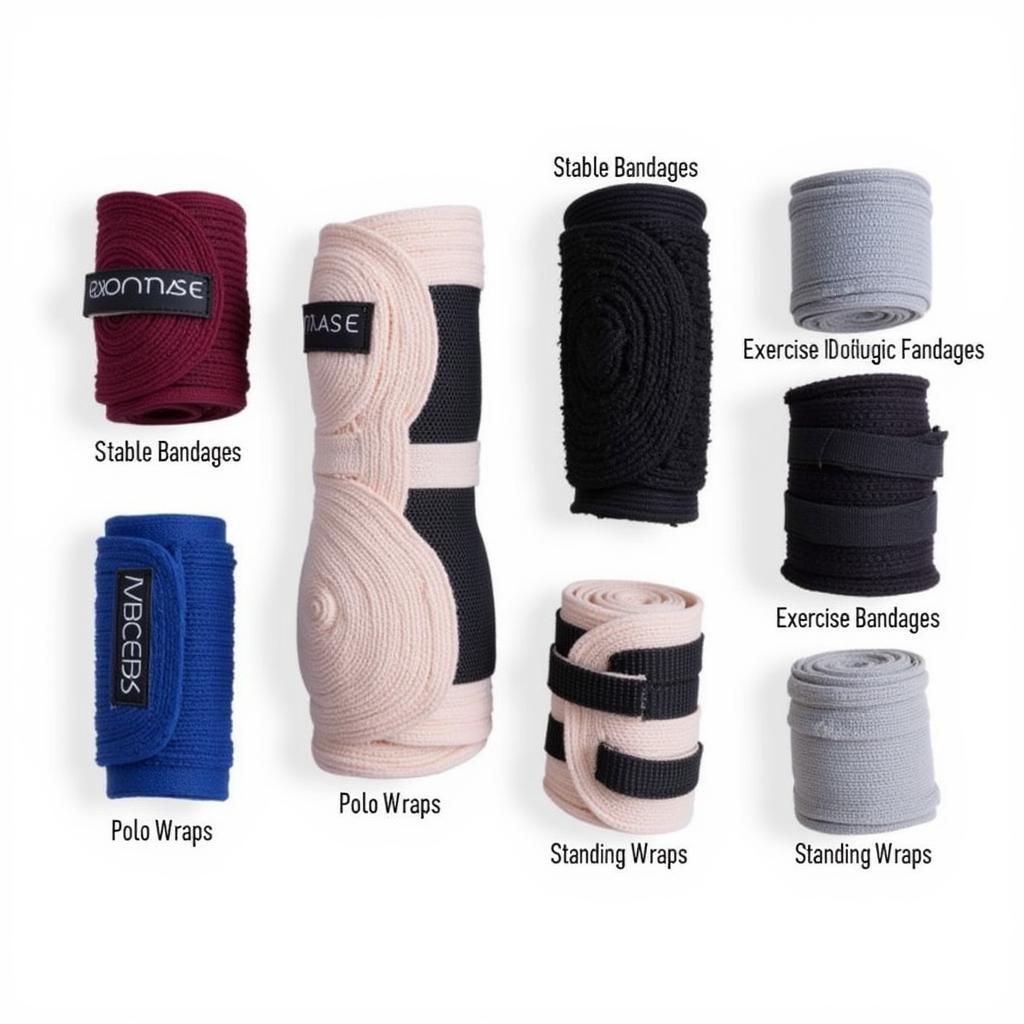Horse Wraps Bandages are essential tools for every horse owner. They offer support, protection, and can aid in healing a variety of leg injuries. Understanding the different types of horse wraps bandages, their proper application, and potential risks is crucial for ensuring your horse’s well-being.
Types of Horse Wraps Bandages
There are various horse wraps bandages available, each designed for a specific purpose. Choosing the right type depends on the situation and your horse’s needs. Some common types include:
- Stable bandages: These are typically used for support and protection during stall rest or transportation. They are thicker and offer more padding than other types.
- Exercise bandages: These are lighter and more flexible, designed to provide support and protection during exercise. They help to prevent injuries and reduce strain on tendons and ligaments.
- Polo wraps: These are made from a stretchy fleece material and are used for support during exercise, particularly in disciplines like polo and jumping.
 Various Horse Wrap Types for Different Needs
Various Horse Wrap Types for Different Needs - Standing bandages: These are similar to stable bandages but are typically used for overnight support or for horses with chronic leg conditions. Like compression wraps for horses, these can help reduce swelling.
Applying Horse Wraps Bandages Correctly
Proper application is essential for the effectiveness and safety of horse wraps bandages. Incorrectly applied bandages can cause pressure sores, restrict circulation, and even worsen existing injuries. Here’s a step-by-step guide:
- Prepare the leg: Ensure the horse’s leg is clean and dry. Apply a thin layer of padding, such as a cotton or quilted wrap.
- Start the wrap: Begin the wrap just below the knee or hock, wrapping in a spiral pattern down the leg.
- Overlap each layer: Overlap each layer of the bandage by about 50% to ensure a secure and even wrap.
- Maintain even tension: Apply even tension throughout the wrap, avoiding tight spots or loose areas.
- Finish the wrap: End the wrap just below the fetlock joint. Secure the bandage with a fastener, ensuring it’s not too tight.
“A common mistake is wrapping too tightly, which can restrict blood flow,” advises Dr. Emily Carter, DVM. “Always check for signs of swelling or discomfort after applying a bandage.”
Potential Risks of Horse Wraps Bandages
While horse wraps bandages can be beneficial, they also carry potential risks if used incorrectly. Some common risks include:
- Pressure sores: Tightly wrapped bandages can restrict blood flow, leading to pressure sores.
- Tendon damage: Incorrectly applied bandages can put undue pressure on tendons, causing damage.
- Overheating: Thick bandages can trap heat, leading to overheating of the leg.
Remember, using horse liniment for pain can help alleviate discomfort, but addressing the root cause of the pain is essential.
When to Use Horse Wraps Bandages
Knowing when to use horse wraps bandages is as important as knowing how to apply them correctly. Some common situations include:
- Support during exercise: Exercise bandages can provide support and prevent injuries during strenuous activities.
- Stall rest: Stable bandages offer support and protection for horses on stall rest. They can also be beneficial if you’re dealing with horse wind puffs.
- Injury recovery: Horse leg wraps for swelling can aid in the healing of leg injuries, providing support and compression to reduce inflammation.
- Transportation: Bandages can protect the horse’s legs during transportation. If you’re considering long-distance transport, be sure to check out Crazy Horse Transport LLC.
Conclusion
Horse wraps bandages are valuable tools for equine leg care, offering support, protection, and aiding in injury recovery. Understanding the different types, proper application techniques, and potential risks is crucial for responsible horse ownership. By following these guidelines, you can ensure your horse’s comfort and well-being.
FAQ
- How often should I change horse wraps bandages?
- What type of padding should I use under horse wraps bandages?
- Can I leave horse wraps bandages on overnight?
- How do I know if a bandage is too tight?
- What are the signs of a pressure sore?
- Can I use horse wraps bandages on a horse with an open wound?
- How do I clean horse wraps bandages?
Situations where horse wrap questions might arise:
- A horse is showing signs of lameness after exercise.
- A horse has sustained a minor leg injury.
- A horse is being prepared for transportation.
- A horse is on stall rest due to an injury or illness.
Related Questions and Resources
- For more information on leg swelling, see our article on horse leg wraps for swelling.
- Learn more about managing horse wind puffs.
If you need assistance, contact us at Phone Number: 0772127271, Email: [email protected] Or visit us at: QGM2+WX2, Vị Trung, Vị Thuỷ, Hậu Giang, Việt Nam. We have a 24/7 customer service team.